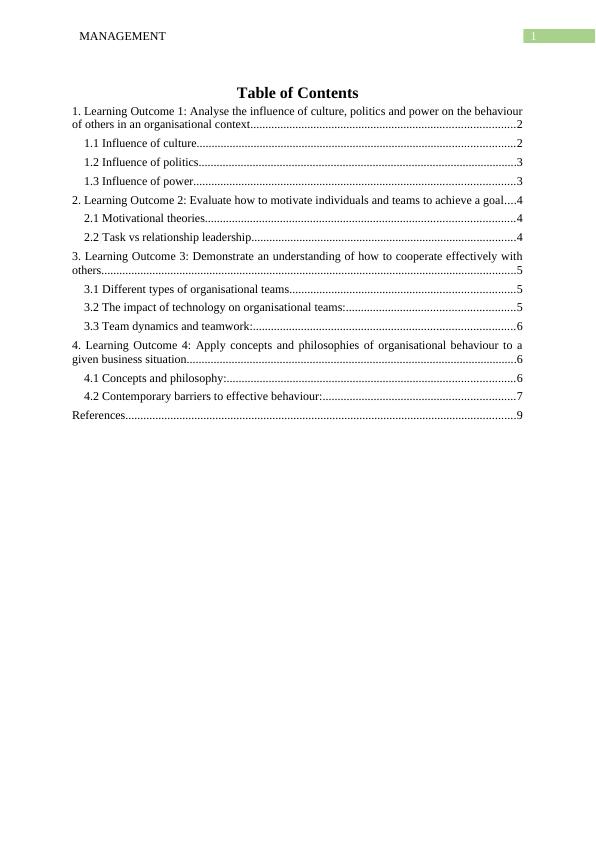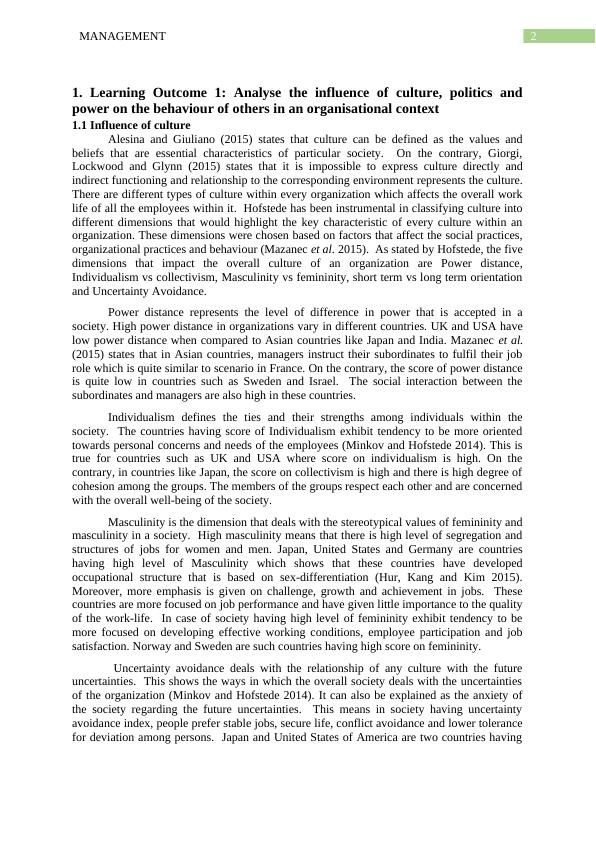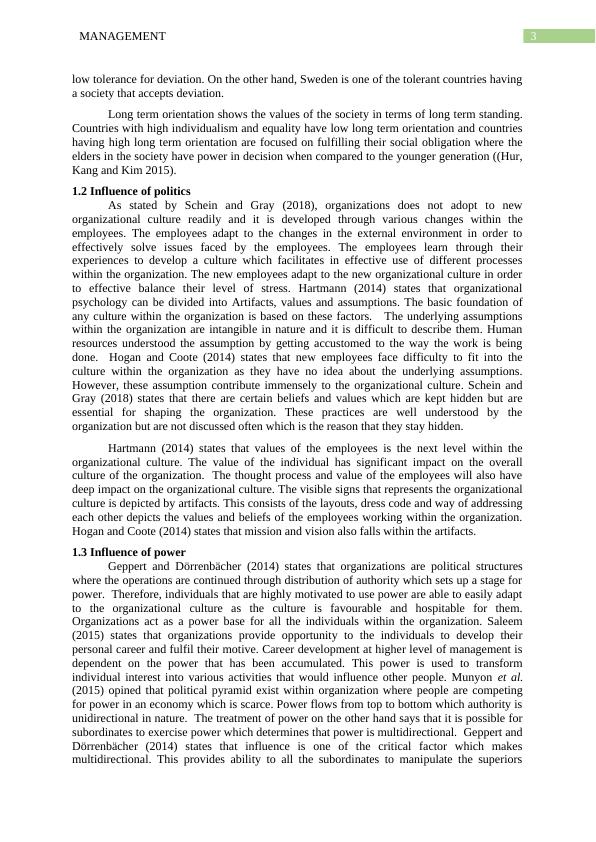Learning about the influence of culture, politics and power on organisational behaviour
Added on 2023-04-22
12 Pages6263 Words455 Views
Running head: MANAGEMENT
Management
Name of the student
Name of the university
Author note
Management
Name of the student
Name of the university
Author note

1MANAGEMENT
Table of Contents
1. Learning Outcome 1: Analyse the influence of culture, politics and power on the behaviour
of others in an organisational context........................................................................................2
1.1 Influence of culture..........................................................................................................2
1.2 Influence of politics..........................................................................................................3
1.3 Influence of power...........................................................................................................3
2. Learning Outcome 2: Evaluate how to motivate individuals and teams to achieve a goal....4
2.1 Motivational theories.......................................................................................................4
2.2 Task vs relationship leadership........................................................................................4
3. Learning Outcome 3: Demonstrate an understanding of how to cooperate effectively with
others..........................................................................................................................................5
3.1 Different types of organisational teams...........................................................................5
3.2 The impact of technology on organisational teams:........................................................5
3.3 Team dynamics and teamwork:.......................................................................................6
4. Learning Outcome 4: Apply concepts and philosophies of organisational behaviour to a
given business situation..............................................................................................................6
4.1 Concepts and philosophy:................................................................................................6
4.2 Contemporary barriers to effective behaviour:................................................................7
References..................................................................................................................................9
Table of Contents
1. Learning Outcome 1: Analyse the influence of culture, politics and power on the behaviour
of others in an organisational context........................................................................................2
1.1 Influence of culture..........................................................................................................2
1.2 Influence of politics..........................................................................................................3
1.3 Influence of power...........................................................................................................3
2. Learning Outcome 2: Evaluate how to motivate individuals and teams to achieve a goal....4
2.1 Motivational theories.......................................................................................................4
2.2 Task vs relationship leadership........................................................................................4
3. Learning Outcome 3: Demonstrate an understanding of how to cooperate effectively with
others..........................................................................................................................................5
3.1 Different types of organisational teams...........................................................................5
3.2 The impact of technology on organisational teams:........................................................5
3.3 Team dynamics and teamwork:.......................................................................................6
4. Learning Outcome 4: Apply concepts and philosophies of organisational behaviour to a
given business situation..............................................................................................................6
4.1 Concepts and philosophy:................................................................................................6
4.2 Contemporary barriers to effective behaviour:................................................................7
References..................................................................................................................................9

2MANAGEMENT
1. Learning Outcome 1: Analyse the influence of culture, politics and
power on the behaviour of others in an organisational context
1.1 Influence of culture
Alesina and Giuliano (2015) states that culture can be defined as the values and
beliefs that are essential characteristics of particular society. On the contrary, Giorgi,
Lockwood and Glynn (2015) states that it is impossible to express culture directly and
indirect functioning and relationship to the corresponding environment represents the culture.
There are different types of culture within every organization which affects the overall work
life of all the employees within it. Hofstede has been instrumental in classifying culture into
different dimensions that would highlight the key characteristic of every culture within an
organization. These dimensions were chosen based on factors that affect the social practices,
organizational practices and behaviour (Mazanec et al. 2015). As stated by Hofstede, the five
dimensions that impact the overall culture of an organization are Power distance,
Individualism vs collectivism, Masculinity vs femininity, short term vs long term orientation
and Uncertainty Avoidance.
Power distance represents the level of difference in power that is accepted in a
society. High power distance in organizations vary in different countries. UK and USA have
low power distance when compared to Asian countries like Japan and India. Mazanec et al.
(2015) states that in Asian countries, managers instruct their subordinates to fulfil their job
role which is quite similar to scenario in France. On the contrary, the score of power distance
is quite low in countries such as Sweden and Israel. The social interaction between the
subordinates and managers are also high in these countries.
Individualism defines the ties and their strengths among individuals within the
society. The countries having score of Individualism exhibit tendency to be more oriented
towards personal concerns and needs of the employees (Minkov and Hofstede 2014). This is
true for countries such as UK and USA where score on individualism is high. On the
contrary, in countries like Japan, the score on collectivism is high and there is high degree of
cohesion among the groups. The members of the groups respect each other and are concerned
with the overall well-being of the society.
Masculinity is the dimension that deals with the stereotypical values of femininity and
masculinity in a society. High masculinity means that there is high level of segregation and
structures of jobs for women and men. Japan, United States and Germany are countries
having high level of Masculinity which shows that these countries have developed
occupational structure that is based on sex-differentiation (Hur, Kang and Kim 2015).
Moreover, more emphasis is given on challenge, growth and achievement in jobs. These
countries are more focused on job performance and have given little importance to the quality
of the work-life. In case of society having high level of femininity exhibit tendency to be
more focused on developing effective working conditions, employee participation and job
satisfaction. Norway and Sweden are such countries having high score on femininity.
Uncertainty avoidance deals with the relationship of any culture with the future
uncertainties. This shows the ways in which the overall society deals with the uncertainties
of the organization (Minkov and Hofstede 2014). It can also be explained as the anxiety of
the society regarding the future uncertainties. This means in society having uncertainty
avoidance index, people prefer stable jobs, secure life, conflict avoidance and lower tolerance
for deviation among persons. Japan and United States of America are two countries having
1. Learning Outcome 1: Analyse the influence of culture, politics and
power on the behaviour of others in an organisational context
1.1 Influence of culture
Alesina and Giuliano (2015) states that culture can be defined as the values and
beliefs that are essential characteristics of particular society. On the contrary, Giorgi,
Lockwood and Glynn (2015) states that it is impossible to express culture directly and
indirect functioning and relationship to the corresponding environment represents the culture.
There are different types of culture within every organization which affects the overall work
life of all the employees within it. Hofstede has been instrumental in classifying culture into
different dimensions that would highlight the key characteristic of every culture within an
organization. These dimensions were chosen based on factors that affect the social practices,
organizational practices and behaviour (Mazanec et al. 2015). As stated by Hofstede, the five
dimensions that impact the overall culture of an organization are Power distance,
Individualism vs collectivism, Masculinity vs femininity, short term vs long term orientation
and Uncertainty Avoidance.
Power distance represents the level of difference in power that is accepted in a
society. High power distance in organizations vary in different countries. UK and USA have
low power distance when compared to Asian countries like Japan and India. Mazanec et al.
(2015) states that in Asian countries, managers instruct their subordinates to fulfil their job
role which is quite similar to scenario in France. On the contrary, the score of power distance
is quite low in countries such as Sweden and Israel. The social interaction between the
subordinates and managers are also high in these countries.
Individualism defines the ties and their strengths among individuals within the
society. The countries having score of Individualism exhibit tendency to be more oriented
towards personal concerns and needs of the employees (Minkov and Hofstede 2014). This is
true for countries such as UK and USA where score on individualism is high. On the
contrary, in countries like Japan, the score on collectivism is high and there is high degree of
cohesion among the groups. The members of the groups respect each other and are concerned
with the overall well-being of the society.
Masculinity is the dimension that deals with the stereotypical values of femininity and
masculinity in a society. High masculinity means that there is high level of segregation and
structures of jobs for women and men. Japan, United States and Germany are countries
having high level of Masculinity which shows that these countries have developed
occupational structure that is based on sex-differentiation (Hur, Kang and Kim 2015).
Moreover, more emphasis is given on challenge, growth and achievement in jobs. These
countries are more focused on job performance and have given little importance to the quality
of the work-life. In case of society having high level of femininity exhibit tendency to be
more focused on developing effective working conditions, employee participation and job
satisfaction. Norway and Sweden are such countries having high score on femininity.
Uncertainty avoidance deals with the relationship of any culture with the future
uncertainties. This shows the ways in which the overall society deals with the uncertainties
of the organization (Minkov and Hofstede 2014). It can also be explained as the anxiety of
the society regarding the future uncertainties. This means in society having uncertainty
avoidance index, people prefer stable jobs, secure life, conflict avoidance and lower tolerance
for deviation among persons. Japan and United States of America are two countries having

3MANAGEMENT
low tolerance for deviation. On the other hand, Sweden is one of the tolerant countries having
a society that accepts deviation.
Long term orientation shows the values of the society in terms of long term standing.
Countries with high individualism and equality have low long term orientation and countries
having high long term orientation are focused on fulfilling their social obligation where the
elders in the society have power in decision when compared to the younger generation ((Hur,
Kang and Kim 2015).
1.2 Influence of politics
As stated by Schein and Gray (2018), organizations does not adopt to new
organizational culture readily and it is developed through various changes within the
employees. The employees adapt to the changes in the external environment in order to
effectively solve issues faced by the employees. The employees learn through their
experiences to develop a culture which facilitates in effective use of different processes
within the organization. The new employees adapt to the new organizational culture in order
to effective balance their level of stress. Hartmann (2014) states that organizational
psychology can be divided into Artifacts, values and assumptions. The basic foundation of
any culture within the organization is based on these factors. The underlying assumptions
within the organization are intangible in nature and it is difficult to describe them. Human
resources understood the assumption by getting accustomed to the way the work is being
done. Hogan and Coote (2014) states that new employees face difficulty to fit into the
culture within the organization as they have no idea about the underlying assumptions.
However, these assumption contribute immensely to the organizational culture. Schein and
Gray (2018) states that there are certain beliefs and values which are kept hidden but are
essential for shaping the organization. These practices are well understood by the
organization but are not discussed often which is the reason that they stay hidden.
Hartmann (2014) states that values of the employees is the next level within the
organizational culture. The value of the individual has significant impact on the overall
culture of the organization. The thought process and value of the employees will also have
deep impact on the organizational culture. The visible signs that represents the organizational
culture is depicted by artifacts. This consists of the layouts, dress code and way of addressing
each other depicts the values and beliefs of the employees working within the organization.
Hogan and Coote (2014) states that mission and vision also falls within the artifacts.
1.3 Influence of power
Geppert and Dörrenbächer (2014) states that organizations are political structures
where the operations are continued through distribution of authority which sets up a stage for
power. Therefore, individuals that are highly motivated to use power are able to easily adapt
to the organizational culture as the culture is favourable and hospitable for them.
Organizations act as a power base for all the individuals within the organization. Saleem
(2015) states that organizations provide opportunity to the individuals to develop their
personal career and fulfil their motive. Career development at higher level of management is
dependent on the power that has been accumulated. This power is used to transform
individual interest into various activities that would influence other people. Munyon et al.
(2015) opined that political pyramid exist within organization where people are competing
for power in an economy which is scarce. Power flows from top to bottom which authority is
unidirectional in nature. The treatment of power on the other hand says that it is possible for
subordinates to exercise power which determines that power is multidirectional. Geppert and
Dörrenbächer (2014) states that influence is one of the critical factor which makes
multidirectional. This provides ability to all the subordinates to manipulate the superiors
low tolerance for deviation. On the other hand, Sweden is one of the tolerant countries having
a society that accepts deviation.
Long term orientation shows the values of the society in terms of long term standing.
Countries with high individualism and equality have low long term orientation and countries
having high long term orientation are focused on fulfilling their social obligation where the
elders in the society have power in decision when compared to the younger generation ((Hur,
Kang and Kim 2015).
1.2 Influence of politics
As stated by Schein and Gray (2018), organizations does not adopt to new
organizational culture readily and it is developed through various changes within the
employees. The employees adapt to the changes in the external environment in order to
effectively solve issues faced by the employees. The employees learn through their
experiences to develop a culture which facilitates in effective use of different processes
within the organization. The new employees adapt to the new organizational culture in order
to effective balance their level of stress. Hartmann (2014) states that organizational
psychology can be divided into Artifacts, values and assumptions. The basic foundation of
any culture within the organization is based on these factors. The underlying assumptions
within the organization are intangible in nature and it is difficult to describe them. Human
resources understood the assumption by getting accustomed to the way the work is being
done. Hogan and Coote (2014) states that new employees face difficulty to fit into the
culture within the organization as they have no idea about the underlying assumptions.
However, these assumption contribute immensely to the organizational culture. Schein and
Gray (2018) states that there are certain beliefs and values which are kept hidden but are
essential for shaping the organization. These practices are well understood by the
organization but are not discussed often which is the reason that they stay hidden.
Hartmann (2014) states that values of the employees is the next level within the
organizational culture. The value of the individual has significant impact on the overall
culture of the organization. The thought process and value of the employees will also have
deep impact on the organizational culture. The visible signs that represents the organizational
culture is depicted by artifacts. This consists of the layouts, dress code and way of addressing
each other depicts the values and beliefs of the employees working within the organization.
Hogan and Coote (2014) states that mission and vision also falls within the artifacts.
1.3 Influence of power
Geppert and Dörrenbächer (2014) states that organizations are political structures
where the operations are continued through distribution of authority which sets up a stage for
power. Therefore, individuals that are highly motivated to use power are able to easily adapt
to the organizational culture as the culture is favourable and hospitable for them.
Organizations act as a power base for all the individuals within the organization. Saleem
(2015) states that organizations provide opportunity to the individuals to develop their
personal career and fulfil their motive. Career development at higher level of management is
dependent on the power that has been accumulated. This power is used to transform
individual interest into various activities that would influence other people. Munyon et al.
(2015) opined that political pyramid exist within organization where people are competing
for power in an economy which is scarce. Power flows from top to bottom which authority is
unidirectional in nature. The treatment of power on the other hand says that it is possible for
subordinates to exercise power which determines that power is multidirectional. Geppert and
Dörrenbächer (2014) states that influence is one of the critical factor which makes
multidirectional. This provides ability to all the subordinates to manipulate the superiors

End of preview
Want to access all the pages? Upload your documents or become a member.
Related Documents
Impact of Organisational Environment on Team Performancelg...
|19
|3507
|31
Study Skills for Higher Educationlg...
|12
|2710
|66
International Human Resource Management in Japan | Reportlg...
|11
|3129
|43
Cross Cultural Management Case Study of Euro Disneylandlg...
|13
|2974
|107
Study Skills for Higher Education: Assignmentlg...
|6
|1467
|107
Global Business Cultural Analysis of Indialg...
|23
|4635
|94
